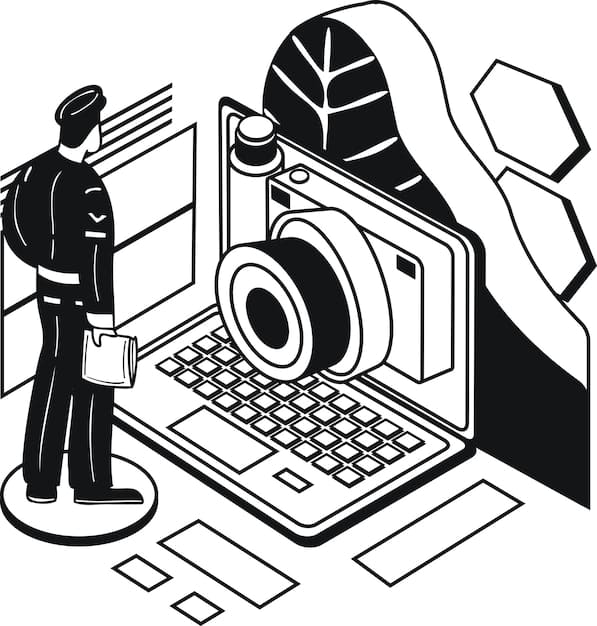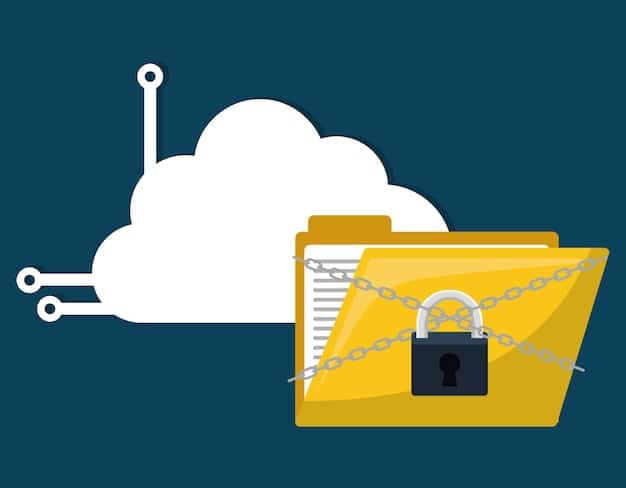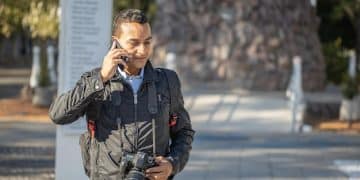Protecting Sources: Best Practices for Journalists in the Digital Age

Anúncios
Protecting sources in the digital age is critical for online journalists in the US, requiring a combination of secure communication methods, robust data protection strategies, and a thorough understanding of legal and ethical obligations to maintain confidentiality and trust.
Anúncios
In the fast-evolving digital landscape, the role of online journalists in the US is more critical than ever, but so are the challenges they face in safeguarding their sources. Protecting sources in the digital age is now paramount, demanding a blend of cutting-edge technology, ethical practices, and legal awareness to ensure confidentiality and foster trust.
Understanding the Landscape: Digital Risks for Journalists
The digital age presents unprecedented risks to journalists and their sources. From sophisticated surveillance technologies to the increasing prevalence of data breaches, understanding these threats is the first step toward effective protection.
Anúncios
Evolving Surveillance Technologies
Governmental and private entities employ increasingly advanced surveillance tools that can compromise the anonymity of sources. Recognizing the capabilities of these technologies is crucial for developing countermeasures.
Data Breaches and Cybersecurity Threats
News organizations and individual journalists are prime targets for cyberattacks. Data breaches can expose sensitive information, including source identities, leading to severe repercussions.

These digital perils necessitate a comprehensive approach to source protection. Journalists must adopt multifaceted strategies that encompass secure communication, data encryption, and legal awareness.
- Encryption Tools: Implementing end-to-end encryption on all communication channels.
- Secure Platforms: Utilizing secure messaging apps and platforms designed for sensitive information exchange.
- Regular Audits: Conducting routine security audits to identify and address vulnerabilities.
By being proactive and informed, journalists can significantly enhance their ability to safeguard their sources in the digital realm.
Secure Communication Channels: Encryption and Beyond
Establishing secure communication channels is fundamental to protecting sources in the digital age. Encryption is the cornerstone, but journalists should explore a range of tools and techniques to ensure confidentiality.
End-to-End Encryption: The Gold Standard
End-to-end encryption (E2EE) ensures that only the sender and receiver can read the messages, protecting communications from eavesdropping. Applications like Signal and WhatsApp offer E2EE as a default.
Secure Messaging Apps
Beyond encryption, secure messaging apps provide additional features like disappearing messages, screen security, and secure storage. These apps help minimize the risk of data breaches.
However, relying solely on encryption is insufficient. Journalists must also educate their sources on digital safety practices, ensuring both parties are aligned in their security measures.
- Signal: Known for its robust encryption and focus on privacy.
- Wire: Offers end-to-end encryption and a range of collaboration tools.
- ProtonMail: An encrypted email service based in Switzerland, providing secure email communication.
The key is to diversify and adapt security measures to the specific needs and threat landscape. By doing so, journalists can establish communication channels that are as secure as possible.
Anonymous Drop Boxes and Secure File Sharing
For sources who prefer to remain entirely anonymous, anonymous drop boxes and secure file sharing platforms offer invaluable solutions. These tools allow sources to provide information without revealing their identity.
Setting Up an Anonymous Drop Box
An anonymous drop box is a secure online portal where sources can upload documents and messages without disclosing their identity. This requires careful setup and maintenance to ensure anonymity.
Secure File Sharing Platforms
Platforms like SecureDrop provide an encrypted channel for sources to share large files with journalists. These platforms often include additional security features to protect against metadata exposure.

Maintaining the integrity of these systems is paramount. Journalists must regularly audit their drop boxes and file sharing platforms to ensure they remain secure and that no vulnerabilities are exposed.
- SecureDrop: An open-source platform designed for secure and anonymous communication between journalists and sources.
- GlobaLeaks: A free and open-source whistleblowing platform that can be customized for anonymous submissions.
- OnionShare: A tool that allows users to securely and anonymously share files over the Tor network.
By leveraging anonymous drop boxes and secure file sharing platforms, journalists can create a safe space for sources to share sensitive information, thereby enriching their reporting.
Physical Security and Operational Practices
While digital security is crucial, physical security and sound operational practices are equally important. Journalists must develop habits that minimize the risk of exposure and protect their sources’ identities.
Securing Devices and Workspaces
Protecting physical access to devices and workspaces is essential. This includes using strong passwords, enabling two-factor authentication, and securing physical access to offices and homes.
Travel Security Protocols
When traveling to meet sources, journalists should take precautions to avoid surveillance. This includes using burner phones, varying routes, and avoiding suspicious locations.
Adopting these practices requires discipline and vigilance. Journalists must continually assess their security posture and adapt their routines to address emerging threats.
- Use Strong, Unique Passwords: Employ a password manager to generate and store complex passwords securely.
- Enable Two-Factor Authentication: Add an extra layer of security to all accounts that support 2FA.
- Secure Physical Access: Ensure that offices and homes are equipped with adequate security measures, such as alarms and secure locks.
By integrating physical security and operational best practices into their daily routines, journalists can create a comprehensive security framework that protects both themselves and their sources.
Legal and Ethical Considerations in Source Protection
Source protection is not only a matter of technology and practice but also of legal and ethical responsibility. Journalists must understand their rights and obligations to protect their sources in a legal context.
Understanding Shield Laws
Shield laws provide varying degrees of protection to journalists who refuse to disclose their sources. Understanding the scope and limitations of these laws is crucial for journalists operating in the US.
Ethical Obligations to Sources
Beyond legal protections, journalists have ethical obligations to honor promises of confidentiality. This includes understanding the potential risks to sources and taking steps to mitigate those risks.
Navigating these legal and ethical complexities requires careful consideration and consultation with legal experts. Journalists must be prepared to defend their sources’ identities, even in the face of legal pressure.
- Know Your Rights: Familiarize yourself with the shield laws in your state and the protections they offer.
- Honor Confidentiality Agreements: Always keep your promises of confidentiality to sources, regardless of the pressure you face.
- Seek Legal Counsel: Consult with media law experts to understand your legal obligations and rights.
By adhering to legal and ethical standards, journalists can reinforce the trust they have with their sources and uphold the principles of responsible journalism.
Training and Resources for Online Journalists
To effectively protecting sources in the digital age, ongoing training and access to reliable resources are essential. Journalists must continually update their knowledge and skills to stay ahead of evolving threats.
Security Training Programs
Organizations like the Committee to Protect Journalists (CPJ) and the Reporters Committee for Freedom of the Press (RCFP) offer security training programs tailored for journalists. These programs cover a range of topics, from digital security to physical safety.
Online Resources and Guides
Numerous online resources provide guidance on secure communication, data protection, and legal rights. These resources can help journalists stay informed and adapt their practices to new challenges.
Investing in training and leveraging available resources is a continuous process. Journalists must remain proactive in their education to ensure they are equipped to protect their sources effectively.
- Committee to Protect Journalists (CPJ): Offers comprehensive safety guides and security training for journalists.
- Reporters Committee for Freedom of the Press (RCFP): Provides legal resources and support for journalists facing legal challenges.
- Freedom of the Press Foundation (FPF): Offers tools and resources for secure communication and source protection.
By prioritizing training and resources, journalists can strengthen their ability to safeguard their sources and uphold the integrity of their reporting.
| Key Point | Brief Description |
|---|---|
| 🛡️ Encryption | Use end-to-end encryption for all communications with sources. |
| 🔒 Secure Platforms | Utilize secure messaging apps like Signal and anonymous drop boxes. |
| 🏢 Physical Security | Secure devices, workspaces, and adopt secure travel protocols. |
| ⚖️ Legal Awareness | Understand shield laws and ethical obligations to protect sources legally. |
Frequently Asked Questions
▼
End-to-end encryption ensures that only the sender and recipient can read the messages. It is crucial because it prevents eavesdropping by third parties, enhancing source confidentiality and trust.
▼
Anonymous drop boxes allow sources to submit information without revealing their identity, enhancing their security. Journalists must ensure these drop boxes are properly maintained and secured.
▼
Shield laws offer legal protection to journalists by allowing them to refuse to disclose their sources in court. Understanding state-specific shield laws is crucial for journalists in the US.
▼
Journalists should secure their devices and workspaces, use strong passwords, enable two-factor authentication, and adopt secure travel protocols to minimize the risk of physical and digital exposure.
▼
Ongoing training is crucial for staying ahead of evolving digital threats. It helps journalists adopt new security measures and best practices to protect themselves and their sources effectively.
Conclusion
In conclusion, protecting sources in the digital age requires a multifaceted approach that combines secure communication, physical security, legal awareness, and continuous training. By adhering to these best practices, online journalists in the US can safeguard their sources, maintain their credibility, and uphold the principles of responsible journalism.





